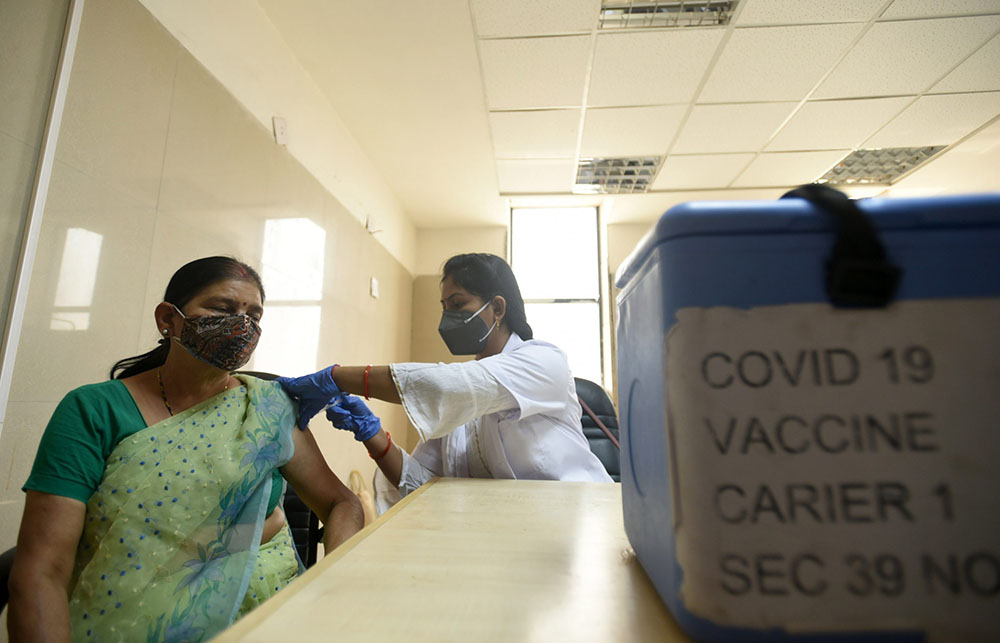
当下,世界各国均深受新冠疫情之苦,印度的新冠确诊与死亡病例数更是几乎每天都在刷新纪录,令人不忍卒视。对美国政府而言,面对严峻的全球疫情形势,从其储存的阿斯利康疫苗中拿出6000万剂疫苗并非多么难做的决定。如今,美国政府应该直面更艰巨的挑战,在全球抗击新冠疫情的战役中真正发挥领导作用。
我们应该承担更多责任,而且应该即刻开始行动。
我们的模型显示,到7月底,美国将有超过2亿剂过剩疫苗可以提供给“新冠肺炎疫苗实施计划”(COVAX)——由全球疫苗免疫联盟(GAVI)、流行病防范创新联盟(CEPI)、联合国儿童基金会(UNICEF)和世界卫生组织(WHO)携手发起——使用,进而在全球拯救50多万人的生命。除非美国政治领袖和疫苗制造商能够在未来几周内开始制定再分配计划,否则这些疫苗最终只能继续储存在冷库中。
当前,美国各地等待接种的疫苗数量已经超过5000万剂,在为每名美国民众预留足够的疫苗之后,截至今年仲夏,美国将至少有1亿剂过剩疫苗(如果我们不能说服更多美国同胞接种疫苗的话,该数字还将更高)。此外,另有1亿剂Novavax公司的疫苗预计将于7月底前获批交付,届时美国政府将拥有至少2亿剂疫苗的库存。
在美国即将与其他国家分享6000万剂阿斯利康疫苗的新闻登上头条之际,有一个细节也值得我们注意,那就是这些疫苗可能在未来数周、乃至数月都未必可以送到需要的人手中。与此同时,美国疫苗接种的推进速度依然堪称缓慢,库存疫苗数量正在以每天近200万剂的速度增加。与其等到夏天才开始重新分配,我们不如现在就把握住机会,将有保障的超额疫苗分享出去,迅速遏制全球疫情的进一步恶化。
要想迅速实现这一目标,白宫需要拿出政治决心,制药企业也需要发挥领导作用并配合相关工作。放宽疫苗原料出口限制等措施也会有所帮助,但世界现在最需要的其实是真正的疫苗。制药企业非常清楚,那些呼吁暂停保护疫苗知识产权的人士忽视了疫苗生产及监管审批过程的复杂性。
紧急再分配计划
我们很自然地会有把疫苗先分享给盟友和邻国、增加其疫苗供应的冲动,但“新冠肺炎疫苗实施计划”能够帮助我们克服这一冲动,把疫苗分享给更多国家。
考虑到全球已经获批或正在接受监管审批的新冠疫苗产能将达到140亿剂,“新冠肺炎疫苗实施计划”的目标——以更公平的方式为全球20%最易感染新冠的人群提供20亿剂疫苗及相关支持,其实不算太高。截至目前,提供给该计划的产量仅够其为全球提供约4500万剂疫苗。虽然该组织今年确定将会获得15亿剂疫苗,但其中大部分预计要到秋冬季节才可以供应到位。
更为棘手的是,由于印度疫情极度严峻,该国已经禁止印度血清研究所(Serum Institute of India)对外出口疫苗,从而导致“新冠肺炎疫苗实施计划”的供应越发短缺。在许多缺少疫苗供应的低收入和中等收入国家,确诊病例和死亡病例数量正在迅速增加。尽管世界银行(World Bank)已经提供120亿美元可用资金,但现在的问题是在短期内根本买不到疫苗。
“新冠肺炎疫苗实施计划”已经制定了出厂疫苗再分配的法律架构和运作框架,而我们则能够立刻捐赠产能、允许5到7月生产的疫苗直接发往该计划覆盖的国家,由此降低相关工作的复杂性。如果等到仲夏再捐赠疫苗,那么易感人群可能要到9月或者更晚才可以得到疫苗接种,如此以来,可能会有数十万原本能够活下来的民众付出生命的代价。
新冠疫苗的快速开发是过去50年最伟大的科技成果之一。目前的挑战在于,如何使其成为人类历史上最大的人道主义和公共卫生成就之一。它关系着至少50万人的生命安全。(财富中文网)
李瑞麒(Rich Lesser)是波士顿咨询公司(Boston Consulting Group)的首席执行官,并负责领导商业圆桌会议新冠疫情特别工作组(COVID-19 Taskforce of the Business Roundtable)的相关工作。马林·吉加加(Marin Gjaja)是波士顿咨询公司的董事总经理兼高级合伙人,负责领导全球新冠疫情应对相关工作。
译者:梁宇
审校:夏林
当下,世界各国均深受新冠疫情之苦,印度的新冠确诊与死亡病例数更是几乎每天都在刷新纪录,令人不忍卒视。对美国政府而言,面对严峻的全球疫情形势,从其储存的阿斯利康疫苗中拿出6000万剂疫苗并非多么难做的决定。如今,美国政府应该直面更艰巨的挑战,在全球抗击新冠疫情的战役中真正发挥领导作用。
我们应该承担更多责任,而且应该即刻开始行动。
我们的模型显示,到7月底,美国将有超过2亿剂过剩疫苗可以提供给“新冠肺炎疫苗实施计划”(COVAX)——由全球疫苗免疫联盟(GAVI)、流行病防范创新联盟(CEPI)、联合国儿童基金会(UNICEF)和世界卫生组织(WHO)携手发起——使用,进而在全球拯救50多万人的生命。除非美国政治领袖和疫苗制造商能够在未来几周内开始制定再分配计划,否则这些疫苗最终只能继续储存在冷库中。
当前,美国各地等待接种的疫苗数量已经超过5000万剂,在为每名美国民众预留足够的疫苗之后,截至今年仲夏,美国将至少有1亿剂过剩疫苗(如果我们不能说服更多美国同胞接种疫苗的话,该数字还将更高)。此外,另有1亿剂Novavax公司的疫苗预计将于7月底前获批交付,届时美国政府将拥有至少2亿剂疫苗的库存。
在美国即将与其他国家分享6000万剂阿斯利康疫苗的新闻登上头条之际,有一个细节也值得我们注意,那就是这些疫苗可能在未来数周、乃至数月都未必可以送到需要的人手中。与此同时,美国疫苗接种的推进速度依然堪称缓慢,库存疫苗数量正在以每天近200万剂的速度增加。与其等到夏天才开始重新分配,我们不如现在就把握住机会,将有保障的超额疫苗分享出去,迅速遏制全球疫情的进一步恶化。
要想迅速实现这一目标,白宫需要拿出政治决心,制药企业也需要发挥领导作用并配合相关工作。放宽疫苗原料出口限制等措施也会有所帮助,但世界现在最需要的其实是真正的疫苗。制药企业非常清楚,那些呼吁暂停保护疫苗知识产权的人士忽视了疫苗生产及监管审批过程的复杂性。
紧急再分配计划
我们很自然地会有把疫苗先分享给盟友和邻国、增加其疫苗供应的冲动,但“新冠肺炎疫苗实施计划”能够帮助我们克服这一冲动,把疫苗分享给更多国家。
考虑到全球已经获批或正在接受监管审批的新冠疫苗产能将达到140亿剂,“新冠肺炎疫苗实施计划”的目标——以更公平的方式为全球20%最易感染新冠的人群提供20亿剂疫苗及相关支持,其实不算太高。截至目前,提供给该计划的产量仅够其为全球提供约4500万剂疫苗。虽然该组织今年确定将会获得15亿剂疫苗,但其中大部分预计要到秋冬季节才可以供应到位。
更为棘手的是,由于印度疫情极度严峻,该国已经禁止印度血清研究所(Serum Institute of India)对外出口疫苗,从而导致“新冠肺炎疫苗实施计划”的供应越发短缺。在许多缺少疫苗供应的低收入和中等收入国家,确诊病例和死亡病例数量正在迅速增加。尽管世界银行(World Bank)已经提供120亿美元可用资金,但现在的问题是在短期内根本买不到疫苗。
“新冠肺炎疫苗实施计划”已经制定了出厂疫苗再分配的法律架构和运作框架,而我们则能够立刻捐赠产能、允许5到7月生产的疫苗直接发往该计划覆盖的国家,由此降低相关工作的复杂性。如果等到仲夏再捐赠疫苗,那么易感人群可能要到9月或者更晚才可以得到疫苗接种,如此以来,可能会有数十万原本能够活下来的民众付出生命的代价。
新冠疫苗的快速开发是过去50年最伟大的科技成果之一。目前的挑战在于,如何使其成为人类历史上最大的人道主义和公共卫生成就之一。它关系着至少50万人的生命安全。(财富中文网)
李瑞麒(Rich Lesser)是波士顿咨询公司(Boston Consulting Group)的首席执行官,并负责领导商业圆桌会议新冠疫情特别工作组(COVID-19 Taskforce of the Business Roundtable)的相关工作。马林·吉加加(Marin Gjaja)是波士顿咨询公司的董事总经理兼高级合伙人,负责领导全球新冠疫情应对相关工作。
译者:梁宇
审校:夏林
With countries around the world struggling and India setting new, devasting records for COVID-19 deaths and cases nearly every day, the U.S. government’s decision to share up to 60 million doses from its stockpile of AstraZeneca vaccines was an easy one. Now it’s time to make the more difficult choices and truly lead the global fight against this disease.
We can do more, and we can do so now.
Our modeling suggests that by the end of July, the U.S. will have north of 200 million surplus vaccine doses that could be used by COVAX—the global partnership of GAVI, CEPI, UNICEF, and WHO—to save more than 500,000 lives across the globe. Unless U.S. leaders and vaccine manufacturers start working on a redistribution plan in the coming weeks, those doses will instead end up sitting in cold storage.
We already have more than 50 million doses waiting to be administered across the country. After reserving enough for every American, we will have an excess supply of at least 100 million doses by mid-summer (of course, that figure will be even higher if we do not become more successful at convincing our fellow citizens to get vaccinated). Add to that an additional 100 million doses of Novavax expected to be authorized and delivered by end of July, and the government will be sitting on a stockpile of at least 200 million doses.
Beneath the headline of 60 million AstraZeneca doses set to be shared was the detail that they may not be available for weeks, or even months. Meanwhile, vaccine uptake in the U.S. continues to soften, and we are actively building inventory at a rate of nearly 2 million doses per day. Instead of waiting until the summer to start redistributing, we have an opportunity to share a portion of secured capacity and unused doses today, quickly stymying further outbreaks across the world.
Making this happen quickly will require significant political will from the White House as well as leadership and collaboration from manufacturers. Other efforts, such as relaxing export restrictions on raw vaccine materials, will help, but what the world needs is actual vaccine doses. And as manufacturers know all too well, calls for suspending intellectual-property protections on vaccines are oblivious to the complexities of vaccine production and regulatory approval processes.
An urgent redistribution plan
In sharing vaccine doses, there’s an impulse to immediately bolster the supplies of our allies and neighbors, but COVAX can help us go well beyond.
With global COVID-19 vaccine capacity expected to hit 14 billion doses this year for vaccines currently approved or under regulatory review, COVAX’s goal is relatively modest: to provide 2 billion vaccines and support in order to equitably vaccinate the 20% of the global population that is most vulnerable to the disease. To date, COVAX has only had enough supply to deliver about 45 million doses globally. While the partnership has secured capacity for 1.5 billion doses this year, the bulk of that isn’t expected until fall and winter.
To make matters worse, the dire situation in India has led to export bans on vaccines from the Serum Institute of India, exacerbating COVAX’s supply shortfall. Cases and deaths are rising at rapid rates in many supply-starved low- and middle-income countries. But despite $12 billion in available funding from the World Bank, there is simply no short-term vaccine capacity available for sale.
COVAX already has the legal and operational frameworks in place to redistribute manufactured doses, but we can reduce complexity by deciding to donate capacity now, allowing supply that rolls off the fill-and-finish lines in May, June, and July to go straight to COVAX-supported countries. Waiting until mid-summer to donate physical doses means they may not reach vulnerable arms until September or later, potentially costing hundreds of thousands of lives that could have been saved in the meantime.
***
The rapid development of COVID-19 vaccines has been one of the greatest scientific achievements of the past 50 years. The challenge we now face is to ensure they also become one of our greatest humanitarian and public health achievements. At least half a million lives depend on it.
Rich Lesser is CEO of Boston Consulting Group and leads the COVID-19 Taskforce of the Business Roundtable. Marin Gjaja is a Boston Consulting Group managing director and senior partner and global COVID-19 response leader.






